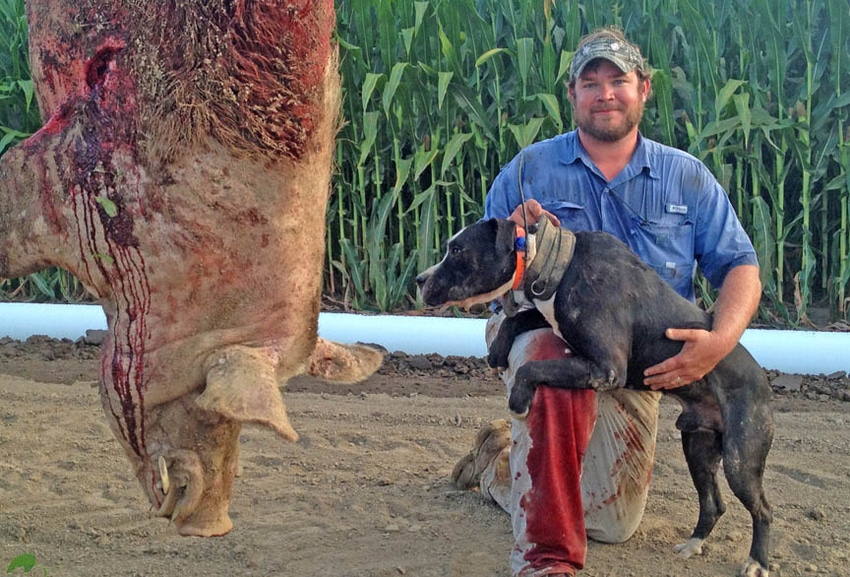August 22, 2013

Larry Smith had never seen anything like it. The beast was standing in a turn row, silhouetted against a background of corn at first light. It had the distinct shape of a hog, but the proportions were off. For Smith, a seasoned hog hunter, the dimensions were simply too big — they couldn’t be right. The body form was in line with a hog, but from his vantage point, the massive size didn’t match up.
Smith, farm manager, Due West Farms, Glendora, Miss., was rattled. “Holy s---. What is that?” Smith was 80 yards away from the biggest feral hog he’d ever seen — dead or alive — in his life. With no rifle in his truck on a July morning, he grabbed a .45 pistol and stepped out of the vehicle, anxious to get a shot off before the hog could get away. He fired several times, but the hog turned, rumbled into the corn, and was gone.
For a photo gallery of the massive Due West wild hog, see Photos: Huge feral pig killed in Mississippi corn field
He felt that one of the rounds might have hit the hog, but he wasn’t sure, and didn’t see any blood on the ground. Before spotting the hog, Smith hadn’t even known Due West had a hog problem and hadn’t seen any recent crop damage. But after a short look around the corn, he found a section that wasn’t merely torn up — it was gone. Typically hogs root up the plant and eat the cob, but not this hog. “Instead of just pulling the ears off, he was eating the whole plant: cob, stalk, and everything. He was just raking down the field,” says Smith.
Cottonmouths, armadillos and leprosy — pick your poison
Photos: Hunting season on, beware the cottonmouth
Shortly after his encounter, one of his farmhands saw the hog as well, and Smith knew he had to act quickly. Despite neighboring farms having hog problems, Smith and Due West hadn’t dealt with any hogs for approximately three years. “Hogs will tear your field to pieces — rooting, ripping out wallows and eating your crop. I knew he was going to decimate my corn. He had no reason to move on. Fresh well water coming in and corn on the cob — he wasn’t going anywhere.”
Loosing the dogs
Smith knew precisely where to go for help. He called close friend and agriculture consultant Michael Mims, Mims Ag, Minter City, Miss. Mims has several trained hog dogs and often hunts down feral hogs for many farmers in the area. The following Saturday, hog dogs in tow, Mims arrived in Glendora. Based on the two sightings and the decimated corn patch, Smith had the search narrowed down to an 80-acre section on 2,000 acres of corn ground. At 5:30 a.m., Smith and Mims led a small hunting party of friends and family into the corn fields of Due West to take down a massive wild hog. And as the chase played out — the hog would prove even bigger than any of them ever suspected.
Smith eased around the edge of the field looking for hog signs and as soon as fresh tracks were found, Mims loosed three baying dogs. They hit on the hog about 150 yards into the corn and started howling, driving the hog out of the field. “He ran out onto the turn row,” Smith says, “and there were a few people close by when he came out and they had to scatter.” Smith’s father, Larry Smith, Sr., was one of those standing in the turn row. As Smith, Sr. describes the moment: “The dogs were raising Cain around the corner, so we hustled down there and that hog was in the turn row and I’m telling you — he was looking like a horse. That hog about ran on top of me. You ever seen a fat, 65-year-old man run?”
For a photo gallery of the massive Due West wild hog, see Photos: Huge feral pig killed in Mississippi corn field
Back into the corn the hog went, and Mims next released two pit bulls — catch dogs for the takedown. They ran into the corn, and with most any other hog, the hunt would have been over — but the chase was only just beginning. The hog came out of the corn again, dragging all the dogs across the road and down to a slough. “The dogs couldn’t get him stopped; he just kept throwing them off,” Smith says.
At this point, the melee included Smith and Mims, who were both in the middle of the scrum, side-by-side with the dogs, trying to bring down the hog. “You could get hurt easily, but I really don’t think about it a whole lot because it’s mainly a rush of adrenaline when you’re fighting a hog. He’s whupping on the dogs and you’re trying to get a hold of him and you can’t let go or he’ll turn and start in on you. You’re not thinking about anything except killing a hog.”
Cottonmouths, armadillos and leprosy — pick your poison
Photos: Hunting season on, beware the cottonmouth
Smith estimates the hog hauled them all another 250 yards before wearing down. But even with the hog finally stopped, his brawn prevented Mims from getting in a kill position. On a typical hunt, the catch dogs grab a hog by the ears and head and a hunter grabs the back legs from behind. The technique — “legging” — stretches the hog out in a wheel-barrow position and allows a hunter to get in close for the stabbing. In this case, the hog was simply too large.
Bringing in a backhoe
“This hog was just too big to leg; we couldn’t do it. We were trying to hold on to his tail and then one of the dogs latched on to his testicles. That dog couldn’t grab the hog’s head, so he grabbed the next best thing,” says Smith. Mims was then able to get behind the front shoulder and stabbed in high with a 10-inch blade, slicing down and catching the heart and lungs — finally killing the hog.
With the brawl over, it was 6 a.m. and Smith and Mims were standing over a massive hog — so heavy it took a backhoe bucket to lift the carcass and carry it to Smith’s farm shop for cleaning. “I didn’t weigh it, but it was 48 inches tall standing hoof to back. On the conservative side, I’m gonna guess the pig weighed at least 700 pounds. When we cut his head off it took two men just to pick it up.”
Cottonmouths, armadillos and leprosy — pick your poison
Photos: Hunting season on, beware the cottonmouth
The left upper tusk was 3 inches long and the left bottom tusk was 7 inches long. The right upper tusk was broken completely off and the right bottom tusk was broken at 5 inches. Lodged in the ribs was a .45 bullet; Smith had aimed well the week before, but to little effect.
The hog was a domesticated-type that had gone feral. It showed a lot of age and Smith guesses the hog got out of a pen years ago and went wild. He believes it had been seen in the Glendora area several times: “Last year, between here and Drew, some fellas killed a sow that was about 550 pounds. The guy that killed her said there was a boar with her that was bigger than she was. That’s only five miles away, so the boar he saw could be this pig. And last year I had a salesman come through and saw this same hog we just killed, or at least he thinks it was the same one, in some beans north of where we killed it. I imagine it’s been roaming around for years.”
A truly immense hog. Does Smith think he’ll ever see one as large? “All my hunting buddies and myself have killed big hogs before. But those would be 350 pounds or close. This is obviously the biggest we’ve ever killed — but you know, I’m guessing there are even bigger ones out there.”
For a photo gallery of the massive Due West wild hog, see Photos: Huge feral pig killed in Mississippi corn field
Follow me on Twitter: @CBennett71
Want the latest in ag news delivered daily to your inbox? Subscribe to Delta Farm Press Daily.
For more
Photos: Hunting season on, beware the cottonmouth
Land forming with a Delta maverick — Robert Precht
Cottonmouths, armadillos and leprosy — pick your poison
About the Author(s)
You May Also Like






